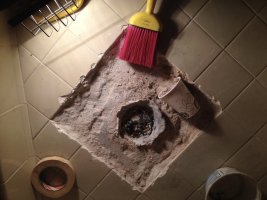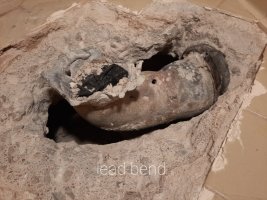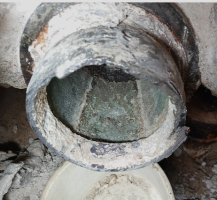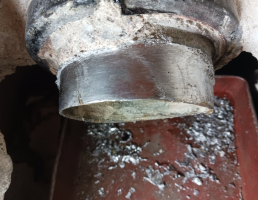I am doing a diy 4-inch waste drain (toilet) lead bend replacement under a slab. So far I've removed the lead bend to leave ferrule, which I think is brass, connected into the cast iron hub.
I've torched the ferrule and scraped away most of the lead, then wiped it with a wet cloth to leave a smooth, thin, shiny surface of remaining lead coating the ferrule , but the actual brass does not show. My plan here is to even up the ferrule's outer edge and then attach a mission no-hub (or similar, like fernco), then assemble the rest of the drain with pvc leading up to the a new flange. The photos show my progress to this point.
All the discussions and Youtube guidance I've found has casually used the words "remove all the lead"when describing their steps with this type of project. My question is pretty simple. Is it really necessary to remove all the lead from the brass ferrule? If the remaining thin coat of lead is thin enough I would think it will be ok to just tighten the no-hub bands against it and that the very thin lead coating on the ferrule would yet make a strong enough surface for a seal against any possible leaks at the no-hub connection. But, this is the first such project I've ever done.
I would appreciate any information from this helpful site by participants that may have experience with this point or otherwise could give some fitting guidance.
I've torched the ferrule and scraped away most of the lead, then wiped it with a wet cloth to leave a smooth, thin, shiny surface of remaining lead coating the ferrule , but the actual brass does not show. My plan here is to even up the ferrule's outer edge and then attach a mission no-hub (or similar, like fernco), then assemble the rest of the drain with pvc leading up to the a new flange. The photos show my progress to this point.
All the discussions and Youtube guidance I've found has casually used the words "remove all the lead"when describing their steps with this type of project. My question is pretty simple. Is it really necessary to remove all the lead from the brass ferrule? If the remaining thin coat of lead is thin enough I would think it will be ok to just tighten the no-hub bands against it and that the very thin lead coating on the ferrule would yet make a strong enough surface for a seal against any possible leaks at the no-hub connection. But, this is the first such project I've ever done.
I would appreciate any information from this helpful site by participants that may have experience with this point or otherwise could give some fitting guidance.





